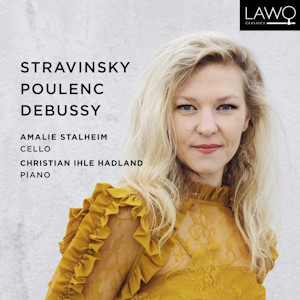
Igor Stravinsky (1882-1971)
Suite Italienne for cello and piano (1932)
Francis Poulenc (1899-1963)
Cello Sonata FP143 (1948)
Claude Debussy (1862-1918)
Cello Sonata (1915)
Amalie Stalheim (cello)
Christian Ihle Hadland (piano)
rec. 2022, Sofienburg Church, Oslo, Norway
LAWO Classics LWC1260 [48]
Cellist Amalie Stalheim (b.1993) and pianist Christian Ihle Hadland (b.1983) are well-established award-winning Norwegian solo performers. The pianist had recorded earlier but this disc seems to be the cellist’s debut. They might have chosen Nordic music – the recording is supported by Arts Council Norway – centred on the Grieg sonata perhaps, or just added that 26 minute work to this 48-minute programme. But let me rather review what they have done: short measure aside, this is a fine recital.
This attractive programme features two French composers and a French-speaking Russian who lived much in France at the time. Also, Stravinsky knew Debussy well, and Poulenc cited Stravinsky as his biggest influence: “nothing makes me prouder than to be the friend of such a man”. There is a coherence here even though each piece sounds quite different, and could only have been written by its composer.
Stravinsky arranged movements from his ballet score Pulcinella of 1920 into Suite Italienne. Pulcinella itself was a re-composition of 18th-century pieces then thought to be by Pergolesi (some were written by other composers of the period). In 1925, Stravinsky produced a version for violin and piano. This cello version was a collaboration with the virtuoso cellist Gregor Piatigorsky.
In all version, Stravinsky recreates rather than just transcribing. His neo-classical manners are evident, and this duo relishes them. The players do very well both the livelier and the more lyrical sections of the so-called Aria (third movement). The tricky fourth movement Tarantella is athletically accomplished on both instruments. The fifth item, a delightfully melodic minuet (originally genuine Pergolesi) is marked Moderato, and is phrased very persuasively. It leads directly into the vigorous finale – which here is Molto vivace indeed, as marked. The score suggest 17 minutes for this Suite. This performance is a mere fourteen seconds shorter, and every speed feels exactly right.
Poulenc’s chamber music with piano favours wind instruments. The piano was his instrument, and he disparaged his own writing for solo strings. Like Stravinsky, he had help from a virtuoso, Pierre Fournier, when he was writing his one cello sonata. They gave the first performance together in Paris in 1949. The composition had a long gestation period, but it still ended up sounding more spontaneous and inventive than deeply pondered. Spontaneity prevails in this account. Lyrical passages enable Amalie Stalheim to show how the cello – instrument closest to the voice, it is sometimes said – can really sing, even with double-stopping. The second movement Cavatine has a touching beauty in Stalheim’s hands. The Ballabile has a swiftly moving first section, alertly played, and the players relax in the middle section as the music seems to invite them to do. The finale (at 6:15, the longest movement on the disc) is perhaps the weakest, but with such responsive and characterful playing it could not be said to outstay its welcome.
Debussy’s Cello Sonata usually plays for around eleven minutes, like here, but in terms of expressive power it comes across as the most substantial work in this programme. The imposing opening is very grandly stated by piano then cello. We then hear the first of many switches of mood in the sonata, wearily melancholy before a stirring return to the opening gesture and a subtly phrased exit. The central Sérénade is elusive in manner. Debussy initially considered a subtitle referring to Pierrot, the sad jester from the Commedia dell’arte theatrical tradition. The cellist captures something of this whimsy when playing both pizzicato and arco. There is a soaring exultation in Stalheim’s playing in the finale which sets the seal on an excellent and well-recorded recital. There is Philip Borg-Wheeler’s very good booklet note, and notes on the performers, all in English only.
Debussy’s sonata is much recorded, the other two pieces less so. I do not know of a recording of these three intriguing pieces together, so this valuable programme should satisfy anyone with interest in this repertoire.
Roy Westbrook
Help us financially by purchasing from




















